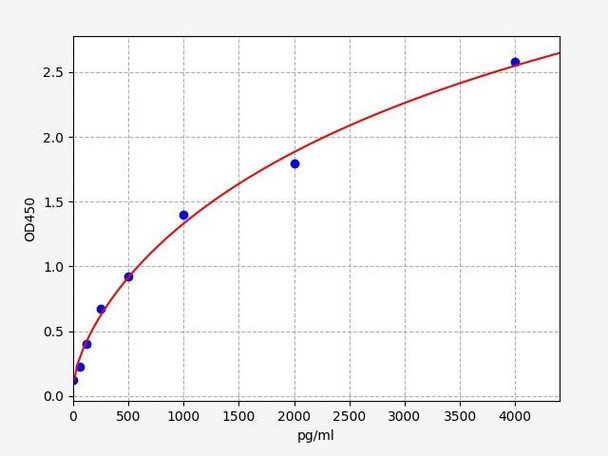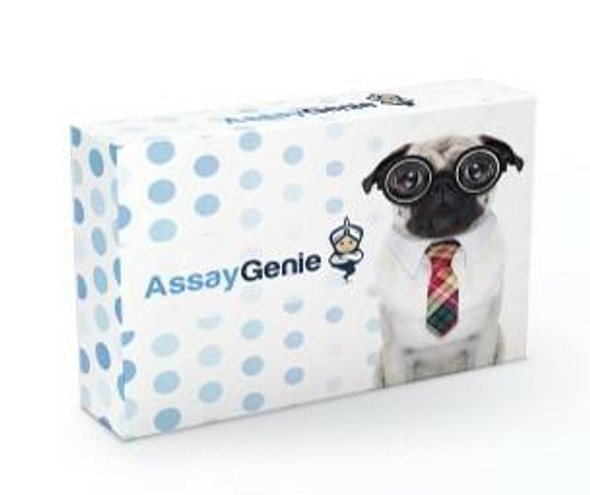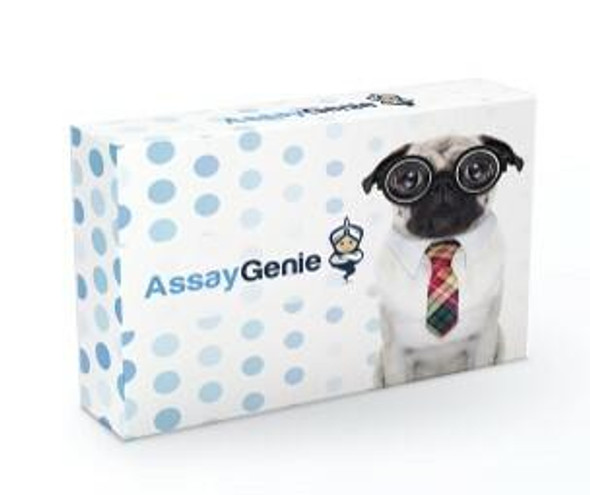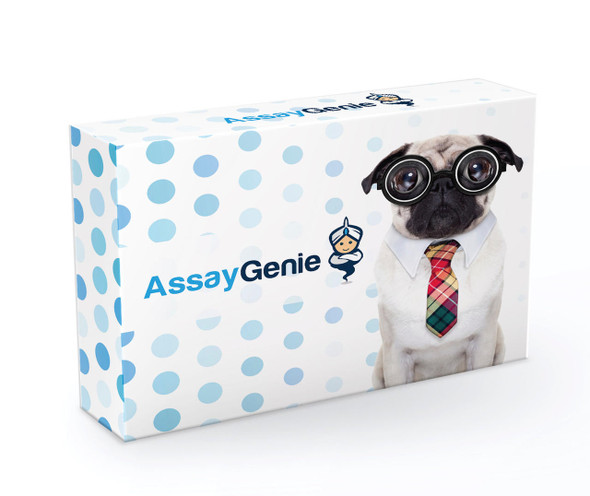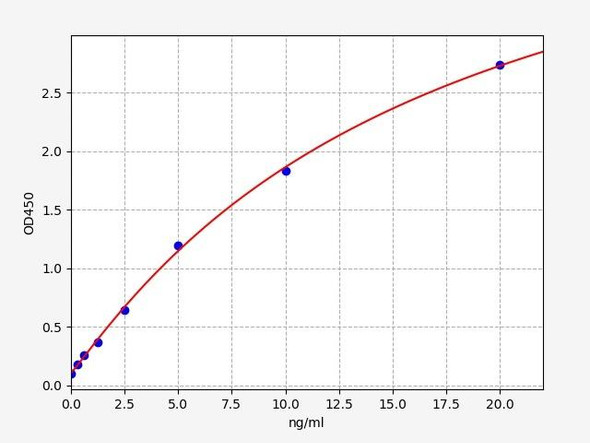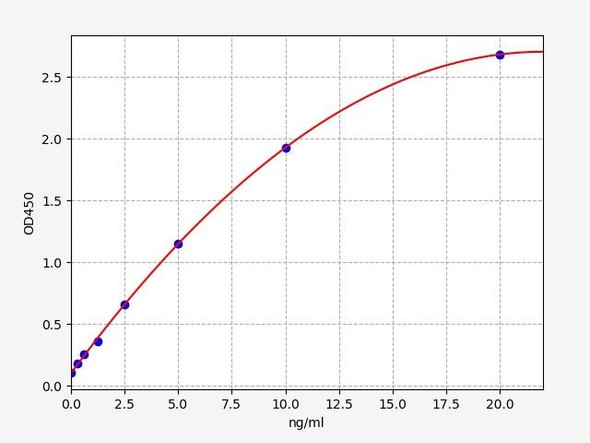Mouse Immunology ELISA Kits
Mouse IGF 1 ELISA Kit
- SKU:
- MOFI00048
- Product Type:
- ELISA Kit
- Size:
- 96 Assays
- Uniprot:
- P05017
- Sensitivity:
- 37.5pg/ml
- Range:
- 62.5-4000pg/ml
- ELISA Type:
- Sandwich
- Synonyms:
- IGF-1, IGF1, IGFI, IGF-I, IGF1A, IGF-IA, IGF-IB, MGF, Somatomedin C
- Reactivity:
- Mouse
Description
| Product Name: | Mouse IGF 1 ELISA Kit |
| Product Code: | MOFI00048 |
| Size: | 96 Assays |
| Alias: | IGF-1, IGF1, IGFI, IGF-I, IGF1A, IGF-IA, IGF-IB, MGF, Somatomedin C |
| Detection Method: | Sandwich ELISA |
| Application: | This immunoassay kit allows for the in vitro quantitative determination of Mouse IGF1 concentrations in serum plasma and other biological fluids. |
| Sensitivity: | 37.5pg/ml |
| Range: | 62.5-4000pg/ml |
| Storage: | 4°C for 6 months |
| Note: | For Research Use Only |
| Recovery: | Matrices listed below were spiked with certain level of Mouse IGF1 and the recovery rates were calculated by comparing the measured value to the expected amount of Mouse IGF1 in samples. | ||||||||||||||||
| |||||||||||||||||
| Linearity: | The linearity of the kit was assayed by testing samples spiked with appropriate concentration of Mouse IGF1 and their serial dilutions. The results were demonstrated by the percentage of calculated concentration to the expected. | ||||||||||||||||
| |||||||||||||||||
| Intra Assay: | CV <8% | ||||||||||||||||
| Inter Assay: | CV <10% |
| Component | Quantity | Storage |
| ELISA Microplate (Dismountable) | 8×12 strips | 4°C for 6 months |
| Lyophilized Standard | 2 | 4°C/-20°C |
| Sample/Standard Dilution Buffer | 20ml | 4°C |
| Biotin-labeled Antibody(Concentrated) | 120ul | 4°C (Protect from light) |
| Antibody Dilution Buffer | 10ml | 4°C |
| HRP-Streptavidin Conjugate(SABC) | 120ul | 4°C (Protect from light) |
| SABC Dilution Buffer | 10ml | 4°C |
| TMB Substrate | 10ml | 4°C (Protect from light) |
| Stop Solution | 10ml | 4°C |
| Wash Buffer(25X) | 30ml | 4°C |
| Plate Sealer | 5 | - |
Other materials and equipment required:
- Microplate reader with 450 nm wavelength filter
- Multichannel Pipette, Pipette, microcentrifuge tubes and disposable pipette tips
- Incubator
- Deionized or distilled water
- Absorbent paper
- Buffer resevoir
| Uniprot | P05017 |
| UniProt Protein Function: | IGF1: The insulin-like growth factors, isolated from plasma, are structurally and functionally related to insulin but have a much higher growth-promoting activity. May be a physiological regulator of [1-14C]-2-deoxy-D-glucose (2DG) transport and glycogen synthesis in osteoblasts. Stimulates glucose transport in rat bone-derived osteoblastic (PyMS) cells and is effective at much lower concentrations than insulin, not only regarding glycogen and DNA synthesis but also with regard to enhancing glucose uptake. Defects in IGF1 are the cause of insulin-like growth factor I deficiency (IGF1 deficiency). IGF1 deficiency is an autosomal recessive disorder characterized by growth retardation, sensorineural deafness and mental retardation. Belongs to the insulin family. 3 isoforms of the human protein are produced by alternative splicing. |
| UniProt Protein Details: | Protein type:Secreted; Motility/polarity/chemotaxis; Secreted, signal peptide Cellular Component: extracellular space; cell soma; extracellular region; intracellular Molecular Function:integrin binding; protein serine/threonine kinase activator activity; insulin-like growth factor receptor binding; protein binding; growth factor activity; hormone activity; steroid binding; insulin receptor binding Biological Process: positive regulation of transcription, DNA-dependent; regulation of protein metabolic process; chondroitin sulfate proteoglycan biosynthetic process; exocrine pancreas development; water homeostasis; positive regulation of glucose import; positive regulation of fibroblast proliferation; proteoglycan biosynthetic process; inner ear development; positive regulation of DNA binding; muscle hypertrophy; nervous system development; positive regulation of mitosis; positive regulation of protein import into nucleus, translocation; regulation of establishment and/or maintenance of cell polarity; regulation of calcium ion transport; positive regulation of cell growth; positive regulation of phosphoinositide 3-kinase cascade; cell activation; positive regulation of peptidyl-tyrosine phosphorylation; insulin-like growth factor receptor signaling pathway; branching morphogenesis of a tube; response to heat; regulation of gene expression; positive regulation of fat cell differentiation; positive regulation of transcription from RNA polymerase II promoter; alveolus development; positive regulation of epithelial cell proliferation; negative regulation of apoptosis; positive regulation of insulin-like growth factor receptor signaling pathway; positive regulation of smooth muscle cell proliferation; myoblast proliferation; positive regulation of glycogen biosynthetic process; negative regulation of caspase activity; detection of mechanical stimulus involved in sensory perception; positive regulation of activated T cell proliferation; positive regulation of smooth muscle cell migration; regulation of translation; negative regulation of cell proliferation; glial cell differentiation; positive regulation of MAPKKK cascade; mammary gland development; positive regulation of cell proliferation; regulation of steroid hormone receptor signaling pathway; positive regulation of granule cell precursor proliferation; regulation of protein amino acid phosphorylation; phosphoinositide-mediated signaling; multicellular organism growth; myotube cell development; satellite cell compartment self-renewal involved in skeletal muscle regeneration; memory; regulation of cell proliferation; myoblast differentiation; cell proliferation; positive regulation of protein kinase B signaling cascade; positive regulation of osteoblast differentiation; positive regulation of tyrosine phosphorylation of Stat5 protein; positive regulation of glycolysis; blood vessel remodeling; positive regulation of Ras protein signal transduction; cell development; positive regulation of DNA replication; lung development |
| UniProt Code: | P05017 |
| NCBI GenInfo Identifier: | 56405309 |
| NCBI Gene ID: | 16000 |
| NCBI Accession: | P05017.2 |
| UniProt Secondary Accession: | P05017,P05018, Q6LDP4, Q8C4U6, |
| UniProt Related Accession: | P05017 |
| Molecular Weight: | 17,623 Da |
| NCBI Full Name: | Insulin-like growth factor I |
| NCBI Synonym Full Names: | insulin-like growth factor 1 |
| NCBI Official Symbol: | Igf1 |
| NCBI Official Synonym Symbols: | Igf-1; Igf-I; C730016P09Rik |
| NCBI Protein Information: | insulin-like growth factor I; somatomedin |
| UniProt Protein Name: | Insulin-like growth factor I |
| UniProt Synonym Protein Names: | Somatomedin |
| UniProt Gene Name: | Igf1 |
| UniProt Entry Name: | IGF1_MOUSE |
*Note: Protocols are specific to each batch/lot. For the correct instructions please follow the protocol included in your kit.
| Step | Procedure |
| 1. | Set standard, test sample and control (zero) wells on the pre-coated plate respectively, and then, record their positions. It is recommended to measure each standard and sample in duplicate. Wash plate 2 times before adding standard, sample and control (zero) wells! |
| 2. | Aliquot 0.1ml standard solutions into the standard wells. |
| 3. | Add 0.1 ml of Sample / Standard dilution buffer into the control (zero) well. |
| 4. | Add 0.1 ml of properly diluted sample (Human serum, plasma, tissue homogenates and other biological fluids.) into test sample wells. |
| 5. | Seal the plate with a cover and incubate at 37 °C for 90 min. |
| 6. | Remove the cover and discard the plate content, clap the plate on the absorbent filter papers or other absorbent material. Do NOT let the wells completely dry at any time. Wash plate X2. |
| 7. | Add 0.1 ml of Biotin- detection antibody working solution into the above wells (standard, test sample & zero wells). Add the solution at the bottom of each well without touching the side wall. |
| 8. | Seal the plate with a cover and incubate at 37°C for 60 min. |
| 9. | Remove the cover, and wash plate 3 times with Wash buffer. Let wash buffer rest in wells for 1 min between each wash. |
| 10. | Add 0.1 ml of SABC working solution into each well, cover the plate and incubate at 37°C for 30 min. |
| 11. | Remove the cover and wash plate 5 times with Wash buffer, and each time let the wash buffer stay in the wells for 1-2 min. |
| 12. | Add 90 µL of TMB substrate into each well, cover the plate and incubate at 37°C in dark within 10-20 min. (Note: This incubation time is for reference use only, the optimal time should be determined by end user.) And the shades of blue can be seen in the first 3-4 wells (with most concentrated standard solutions), the other wells show no obvious color. |
| 13. | Add 50 µL of Stop solution into each well and mix thoroughly. The color changes into yellow immediately. |
| 14. | Read the O.D. absorbance at 450 nm in a microplate reader immediately after adding the stop solution. |
When carrying out an ELISA assay it is important to prepare your samples in order to achieve the best possible results. Below we have a list of procedures for the preparation of samples for different sample types.
| Sample Type | Protocol |
| Serum: | If using serum separator tubes, allow samples to clot for 30 minutes at room temperature. Centrifuge for 10 minutes at 1,000x g. Collect the serum fraction and assay promptly or aliquot and store the samples at -80°C. Avoid multiple freeze-thaw cycles. If serum separator tubes are not being used, allow samples to clot overnight at 2-8°C. Centrifuge for 10 minutes at 1,000x g. Remove serum and assay promptly or aliquot and store the samples at -80°C. Avoid multiple freeze-thaw cycles. |
| Plasma: | Collect plasma using EDTA or heparin as an anticoagulant. Centrifuge samples at 4°C for 15 mins at 1000 × g within 30 mins of collection. Collect the plasma fraction and assay promptly or aliquot and store the samples at -80°C. Avoid multiple freeze-thaw cycles. Note: Over haemolysed samples are not suitable for use with this kit. |
| Urine & Cerebrospinal Fluid: | Collect the urine (mid-stream) in a sterile container, centrifuge for 20 mins at 2000-3000 rpm. Remove supernatant and assay immediately. If any precipitation is detected, repeat the centrifugation step. A similar protocol can be used for cerebrospinal fluid. |
| Cell culture supernatant: | Collect the cell culture media by pipette, followed by centrifugation at 4°C for 20 mins at 1500 rpm. Collect the clear supernatant and assay immediately. |
| Cell lysates: | Solubilize cells in lysis buffer and allow to sit on ice for 30 minutes. Centrifuge tubes at 14,000 x g for 5 minutes to remove insoluble material. Aliquot the supernatant into a new tube and discard the remaining whole cell extract. Quantify total protein concentration using a total protein assay. Assay immediately or aliquot and store at ≤ -20°C. |
| Tissue homogenates: | The preparation of tissue homogenates will vary depending upon tissue type. Rinse tissue with 1X PBS to remove excess blood & homogenize in 20ml of 1X PBS (including protease inhibitors) and store overnight at ≤ -20°C. Two freeze-thaw cycles are required to break the cell membranes. To further disrupt the cell membranes you can sonicate the samples. Centrifuge homogenates for 5 mins at 5000xg. Remove the supernatant and assay immediately or aliquot and store at -20°C or -80°C. |
| Tissue lysates: | Rinse tissue with PBS, cut into 1-2 mm pieces, and homogenize with a tissue homogenizer in PBS. Add an equal volume of RIPA buffer containing protease inhibitors and lyse tissues at room temperature for 30 minutes with gentle agitation. Centrifuge to remove debris. Quantify total protein concentration using a total protein assay. Assay immediately or aliquot and store at ≤ -20 °C. |
| Breast Milk: | Collect milk samples and centrifuge at 10,000 x g for 60 min at 4°C. Aliquot the supernatant and assay. For long term use, store samples at -80°C. Minimize freeze/thaw cycles. |

